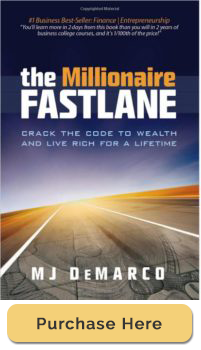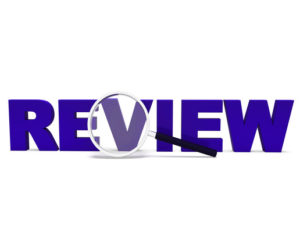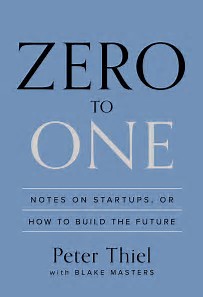
If you are interested in entrepreneurial books, or even if you’re just looking to retire before you turn 75, The Millionaire Fastlane is the book for you. DeMarco packed more than 300 pages of wisdom into this book, so it’s not some quick read that has just a nugget or two. If you’re like me, you’ll find yourself highlighting something on every other page and then telling your friends about what you just read the next time you see them.
Hard Work
DeMarco starts with a warning, “I don’t claim the Fastlane is easy; it’s hard work. If you expect a four-hour workweek here, you will be disappointed.” And he continues by saying that if you’re not rich now, and you want to be, then you should change what you’re doing.
DeMarco has a real problem with the “get rich slow” method that is so common among the middle-class and the money managers that feed off them. “The Slowlane prognosticators know something that they aren’t telling you: What they teach doesn’t work, but selling it does.”
DeMarco is big on process and his book has a lot of it. “Wealth eludes most people because they are preoccupied with events while disregarding process. Without process, there is no event.”
DeMarco goes on to state that people see events all the time — people selling their companies for big money, people getting big contracts with sports teams, etc. These events are only possible with a preceding process.
“If you try to skip process, you’ll never experience events.”
In other words, don’t expect the $50-million-dollar baseball contract if you don’t put in the hard effort to be good enough to get it.
DeMarco warns that there will be hardship and challenges.
“There is no wisdom or personal growth gained in a journey that someone else does for you.”
But ultimately the hardship pays off.
The Three Financial Roadmaps
- The Sidewalk Roadmap – predisposition to poorness
- The Slowlane Roadmap – predisposition to mediocrity
- The Fastlane Roadmap – predisposition to wealth
“Each roadmap contains key mindsets that act as signposts, or “mindposts,” that provide direction and guide actions, just like a roadmap.”
The Sidewalk Roadmap
DeMarco paints the picture of those that have a Sidewalk Roadmap as people that are “fed by an urgent, insatiable need for pleasure, image, and instant gratification.” They don’t plan because they live in the moment. They rationalize that life is too short to worry about plans.
DeMarco lists the following Sidewalking Symptoms:
- You haven’t learned much since graduating from high school or college. “I’m done with school, hooray!” You change jobs frequently.
- You think people with money have it because they had rich parents, luck, or easier life circumstances than you.
- You are easily impressed and seek to impress.
- You have poor credit.
- You put faith into politicians and government to change the system, instead of focusing on how you can change yourself.
- You view pawnshops, payday loan stores, and credit cards as a means of supplemental income.
DeMarco points out that income-rich people that go broke make headlines and the public wonders why. The reason, according to DeMarco, is that “more money doesn’t buy financial discipline.”
So when a Sidewalker becomes a rap star and makes millions in a few years, and then fades into the background and goes broke in just a few years, it shouldn’t be a surprise, because the lack of financial discipline resulted in spending and debt that far surpassed income.
“Wealth is not authored by material possessions, money, or “stuff,” but by what I call the three fundamental “F’s”…”
- Family (relationships)
- Fitness (health)
- Freedom (choice)
“Wealth is making a difference. Wealth is community and impacting the lives of others. Wealth cannot be experienced alone in a vacuum.”
DeMarco points out that “consumerism” has been reported to be the “leading obstacle to happiness.” The new “normal” is waking up early, fighting traffic en-route to a job you despise, five days a week. Normal is saving 10% of your income and investing it in the stock market so you can hopefully retire in 50 years.
We are a society of people that rely on instant gratification. And DeMarco points to the side effects of this poisonous reality as both debt and obesity.
“Wealth, like health, isn’t easy and is cut from the same fabric. Their processes are identical. They require discipline, sacrifice, persistence, commitment, and yes, delayed gratification.”
Get Lucky!
I’m a great believer in luck, and I find the harder I work, the more I have of it. ~ Thomas Jefferson
DeMarco writes an entire chapter that could just be summarized as “work hard.” He states,
“…process creates events that others see as luck.”
The Sidewalker is paralyzed by their belief that only the lucky get rich, and they never choose to engage in the process of working toward something. “If you want luck, engage in a process, because process raises events from the ashes.”
The Slowlane Roadmap
The Slowlane, according to DeMarco, is a series of trade-offs. If I save now, it’ll pay off down the road. If I exchange eating out for a bag lunch, I’ll be better off down the road. If I give my money to the 401(k) financial gurus, it will all work out in the end.
“The Slowlane is a lifetime wager that a sacrificial today will yield a wealthier tomorrow.”
But DeMarco points out that the “global recession has exposed the Slowlane for the fraud it is. With no job, the plan fails. When the stock market loses 50% of your savings, the plan fails. When a housing crisis erases 40% of your illiquid net worth in one year, the plan fails. The plan is a failure because the plan is based on time and factors you can’t control.”
Slowlane Mindposts
- Debt Perception: Debt is evil. It must be religiously attacked, even if that means working overtime for life.
- Time Perception: My time is abundant and I will gladly trade my time for more dollars. The more hours I can work, the more I can pay off my debt and save money for retirement at 65.
- Education Perception: Education is important because it helps me earn a bigger salary.
- Money Perception: Money is scarce and every dime and dollar must be accounted for, budgeted, and perilously saved. If I want to retire by 65 with millions, I have to ensure I don’t squander my hard-earned money.
- Primary Income Source: My job is my sole source of income.
- Primary Wealth Accelerator: Compound interest is powerful because $10 invested today will be worth $300,000 in 50 years. Oh yes, and don’t forget about mutual funds, home appreciation, and my employer’s 401(k).
- Wealth Perception: Work, save, and invest. Work, save, and invest. Repeat for 40 years until retirement age . . . 65 years old or, if I’m lucky and the markets return 12% yearly, maybe 55!
- Wealth Equation: Wealth = job + market investments.
- Destination: A comfortable retirement in my twilight years.
- Responsibility & Control: It’s my responsibility to provide for my family although for that plan to work I have to rely on others, including my employer, my financial advisor, the government, and a good economy
- Life Perception: Settle for less. Give up on big dreams. Save, live frugal, don’t take unnecessary risks, and one day I will retire with millions.
The Slowlane roadmap
- Go to school
- Get good grades
- Graduate
- Pay yourself first
- Overtime Corporate ladder
- Save X% of your paycheck
- Contribute to your 401(k)
- Invest in mutual funds
- Buy and hold
- Paychecks, pensions, benefits
- Diversify
- Raise your insurance deductibles
- The stock market
- Say “no” to expensive lattes
- Be frugal
- Get out of debt
- Clip coupons
- Cancel your credit cards
- Dollar cost averaging
- Get an advanced degree
- Pay off your house early
- Your home is an asset
- Individual retirement accounts (IRAs)
- Live below your means
- Understand compound interest
DeMarco warns the reader to be wary of the buzzwords listed above, because it’s likely you’re being sold something when you hear them.
Your Job
DeMarco has a rather bold chapter in which he states that your specialization and your job are liabilities to wealth.
“If you want to escape the Slowlane, find wealth and freedom fast, you’ve got to dump the job. Let me repeat. Dump the damn job!”
His main point is that the 5 days a week that are required for a typical job, and the two days of “freedom” on the weekends, is a poor trade-off, and it leaves you with limited control.
In addition, he points out that if your particular specialization becomes obsolete, you may find yourself out of a job and with very little of value in an ever changing world.
The Slowlane: Why Aren’t You Rich?
DeMarco spends a few chapters attacking the mentality of the Slowlane. He attacks the idea that your job is your best way to make more money. He attacks the idea that compound interest is the best way to wealth creation, stating that it is much more likely to be used as wealth preservation.
DeMarco points to research that shows, “only 10% of penta-millionaires (net worth $5 million) report that their wealth came from passive investments.”
He attacks the idea that a higher degree is actually worth the cost associated with it.
“Whether consciously or not, the Slowlaner believes that elevating intrinsic value can create wealth. Want to be highly paid right out of college? Go to medical school and become a doctor. As a physician, your intrinsic value is now worth $200 per hour.” And he continues, “the problem with formal education used to raise intrinsic value is that it’s ungodly expensive in time and money.”
For anyone that reads entrepreneurial books or pays attention to those that make it big in business, they know that many serial entrepreneurs and extremely successful individuals dropped out of school to pursue their dreams.
“While the Sidewalker deals with “Lifestyle Servitude,” the Slowlaner wrestles with “Education Servitude” (freedom eroded by education) that traps the victim to a job.” The Slowlane is based on hopes and expectations. Unfortunately, they are gambling away their most productive years in an endeavor that may not pay off.
“In a 2002 AARP (formerly the American Association of Retired Persons) survey, 69% of the respondents said they would need to work past retirement age. A year earlier, 45% said they would need to work into their 70s and 80s. We can deduce something disturbing from this data: The Slowlane’s failure rate is near 70%.”
The Fastlane Roadmap
DeMarco leaves his solution for the last half of the book. He lists the following Fastlane Mindposts:
- Debt Perception: Debt is useful if it allows me to build and grow my system.
- Time Perception: Time is the most important asset I have, far exceeding money.
- Education Perception: The moment you stop learning is the moment you stop growing. Constant expansion of my knowledge and awareness is critical to my journey.
- Money Perception: Money is everywhere, and it’s extremely abundant. Money is a reflection of how many lives I’ve touched. Money reflects the value I’ve created.
- Primary Income Source: I earn income via my business systems and investments.
- Primary Wealth Accelerator: I make something from nothing. I give birth to assets and make them valuable to the marketplace. Other times, I take existing assets and add value to them.
- Wealth Perception: Build business systems for cash flow and asset valuation.
- Wealth Equation: Wealth = Net Profit + Asset Value Strategy: The more I help, the richer I become in time, money, and personal fulfillment.
- Destination: Lifetime passive income, either through business or investments.
- Responsibility & Control: Life is what I make it. My financial plan is entirely my responsibility and I choose how I react to my circumstances.
- Life Perception: My dreams are worth pursuing no matter how outlandish, and I understand that it will take money to make some of those dreams real.
DeMarco has a variety of strategies for working with a Fastlane mindset and this review isn’t going to cover all of them. Instead, I’ll be showcasing those strategies that were the most memorable.
If any of these strategies seem insightful, you’ll likely benefit from reading the book and seeing how DeMarco presents all that he has to offer in this roadmap to success.
Become a Producer
DeMarco shows how being a Producer is much more likely to result in financial success.
“Instead of buying products on TV, sell products. Instead of digging for gold, sell shovels. Instead of taking a class, offer a class. Instead of borrowing money, lend it. Instead of taking a job, hire for jobs. Instead of taking a mortgage, hold a mortgage. Break free from consumption, switch sides, and reorient to the world as producer.”
This idea of being a producer instead of a consumer is highlighted by showcasing that the rich typically make their money by doing just that — they produce something.
“Fastlaners buy and sell appreciating assets: businesses, brands, cash flows, notes, intellectual property, licenses, inventions, patents, and real estate.”
This mentality of being a producer, or “switching teams,” is similar to the mentality mentioned in the book The Debt Millionaire by George Antone. In that book, Antone suggests “moving to the other side of the equation” in order to receive income from money loaned out.
Divorce Wealth from Time
A big aspect of the Fastlane mentality is that you don’t need to exchange decades of time for wealth. Instead you need to look for ways in which you can leverage your time to your advantage.
“>Money trees are business systems that survive on their own.”
DeMarco ranks the following business systems. You’ll notice that Human Resource Systems are graded the lowest.
Seedling 1: Rental Systems (Passivity Grade: A)
Seedling 2: Computer/Software Systems (Passivity Grade: A-)
Seedling 3: Content Systems (Passivity Grade: B+) Content systems are systems of information. That information can be fused to a variety of other systems, like the Internet and physical distribution systems.
Seedling 4: Distribution Systems (Passivity Grade: B)
Seedling 5: Human Resource Systems (Passivity Grade: C)
Become a Bank
“Money is the king of money trees…if you have a lot of money, you’re given the gate key to switch teams from consumer to producer. Specifically, you move from borrower to lender.”
Take your money and help others with it, and in so doing gain a a return and leverage your money. This is exactly what I mentioned earlier was found in George Antone’s book, The Debt Millionaire.
Obviously, those with a lot of money can make a lot of money by lending it out. But the principle is sound even for those with a lot less money. You don’t have to have millions in the bank to start lending.
In fact, here at Insurance & Estates we’ve written extensively about Infinite Banking and Life Insurance options that enable personal lending with very little initially invested.
Impact the Masses
The book describes the “Law of Effection” as stating “that the more lives you affect in an entity you control, in scale and/or magnitude, the richer you will become.”
In other words, if you impact the masses, you will make a decent profit off of it. The principle is simple in theory, but hard in practice.
But the point DeMarco is making is that you have to have this mindset. “Scale creates millionaires…scale and magnitude creates billionaires.”
You can actually see this in other entrepreneurial books as well. Often times the authors are telling you to find your audience, or look for a problem that needs solving.
In essence, they’re suggesting that you find something that is of value to many others and then offer it to them. Kiyosaki mentions this in his book Second Chance. The key here is that it needs to be something of value to the masses.
The Five Fastlane Commandments
DeMarco concludes the book with his Five Fastlane Commandments. Entrepreneurs who want to be successful will ignore these Commandments at their own peril.
N.E.C.S.T. is the acronym for the Five Fastlane Commandments. DeMarco lists them as:
- The Commandment of Need
- The Commandment of Entry
- The Commandment of Control
- The Commandment of Scale
- The Commandment of Time
These Commandments are the tool that should be used to determine if your business idea has merit and is indeed en-route to wealth.
Selling cookies at the farmers market may be your own business, but it’s not going to make you millions because it doesn’t follow the commandments.
DeMarco states, “a road meeting all five commandments can make you filthy rich fast. As violations accrue, the road degrades in its wealth potential, and with it, your ability to get near Effection also degrades. While it’s possible to violate one or more commandments and still create wealth quickly, you should aim for a road that satisfies all five commandments.”
The Commandment of Need
“Stop thinking about business in terms of your selfish desires, whether it’s money, dreams or ‘do what you love.’ Instead, chase needs, problems, pain points, service deficiencies, and emotions.”
As mentioned earlier, a good business is one that meets a need and hopefully that need is shared by millions. DeMarco cautions that the “do what you love” mentality is rarely successful. “If ‘do what you love’ doesn’t fill a need spectacularly, no one will pay for it!”
The Commandment of Entry
“The Commandment of Entry states that as entry barriers to any business road fall, or lessen, the effectiveness of that road declines while competition in that field subsequently strengthens.” In other words, if it’s easy to get into, the competition is going to be fierce.
DeMarco tried network marketing businesses multiple times and failed. He writes, “could I be the exceptional one among 50,000 like minded “distributors?” I was doubtful. Conversely, when I started my Internet business I had roughly 12 competitors. Could I be exceptional among 12? Absolutely.”
So how do you know if your business violates the Commandment of Entry or not? “The answer is another simple question: Is getting into business an event or a process? Real business startups are processes, not events.”
The Commandment of Control
“Fastlane drivers retain control. Those who violate the commandment do not.”
In general:
- Drivers create MLM companies; they don’t join them.
- Drivers sell franchises; they don’t buy them.
- Drivers offer affiliate programs; they don’t join them.
- Drivers run hedge funds; they don’t invest in them.
- Drivers sell stock; they don’t buy stock.
- Drivers offer drop-shipping; they don’t use drop-shipping.
- Drivers offer employment; they don’t get employed.
- Drivers accept rents and royalties; they don’t pay rents and royalties.
- Drivers sell licenses; they don’t buy them.
- Drivers sell IPO shares; they don’t buy them.
DeMarco has quite a lot to say about network marketing, and pulls from his time spent in four different MLM companies as he writes this book.
“Millions fall for the pitches such as “Be your own boss!” “Own your own company!” or “Passive residual income!” While there is a small sliver of validity to these claims, they cloud the real essence of MLM, which is sales, distribution, and training—not entrepreneurship.”
The Commandment of Scale
DeMarco discusses this fourth commandment by talking about business leverage. He states that each business operates within a specified “habitat.” These “habitats” can be small, large, or massive in scale. The larger the “habitat,” the greater the opportunity for success.
There are six business habitats:
- Local/community (pool)
- County/city (pond)
- Statewide (lagoon)
- Regional (lake)
- National (sea)
- Worldwide (ocean)
DeMarco lists the following questions to be asked about your business with regard to Scale:
- Can the net income of this business scale limitlessly, say, from $2,000 per month to $200,000?
- Can the asset value of this business scale into the millions?
- Can this business impact millions? Or does it impact hundreds? Is its customer pool the world or a small community in the city?
- Can this business be replicated and expanded beyond the local trading area by franchising, chaining, or additional units?
- Best-case scenario, what is the units-sold potential? One hundred or one hundred million?
- Best-case scenario, how pliable is unit profit? Does it have magnitude?
You don’t have to play baseball in front of millions in order to impact millions. If you can sell a product or service over the internet that millions of people want, you have a business that follows the Commandment of Scale.
The Commandment of Time
“The Commandment of Time asks: Can this business be automated and systematized to operate while I’m absent?”
The commandment also asks a handful of other questions that remove your time from the success of the business. DeMarco is not stating that this business will not need any of your time. But he is suggesting that the commandment asks if you could eventually not have to be committed to the business with your time.
“A business attached to your time is a job.”
Juxtaposed with:
“A business that earns income exclusive of your time satisfies the Commandment of Time.”
Lifestyle Guidelines
To wrap up this review, I’ll share just 10 of the 40 Lifestyle Guidelines that DeMarco lists in the last chapter of his book.
I SHALL . . .
- Not dismiss “Get Rich Quick” as improbable.
- Not allow the Slowlane to bury my dreams.
- Not allow Slowlane prognosticators to contaminate my truth with their dogma.
- Not ordain the Slowlane as the plan, but let it be a part of the plan.
- Not sell my soul for a weekend.
- Not expect nor seek a chauffeur to wealth.
- Not trade my time for money.
- Not put time in control over my financial plan.
- Not forsake control over my financial plan.
- Not assign faith to events, but to process.
Conclusion
MJ DeMarco has written an excellent book for those seeking to create wealth and break from the mold. This review has really just scratched the surface of what he has to offer in his book.
Much of what DeMarco proposes can be accomplished using many of the financial vehicles offered here at I&E.
Lending to others via a life insurance policy, or even funding businesses through life insurance is something that our experts know well. If you’d like to find out more about how I&E can help you reach your business or entrepreneurial goals, please contact us today for a free consultation.






1 comment
David
Wow! You provided an excellent summary. While trying to refresh my memory on this book I used your summary which helped me remember how great “The Millionaire Fastlane” is.
My one take away would be when he says “to make a million dollars you need to affect a million people”. It is about scaling your business.